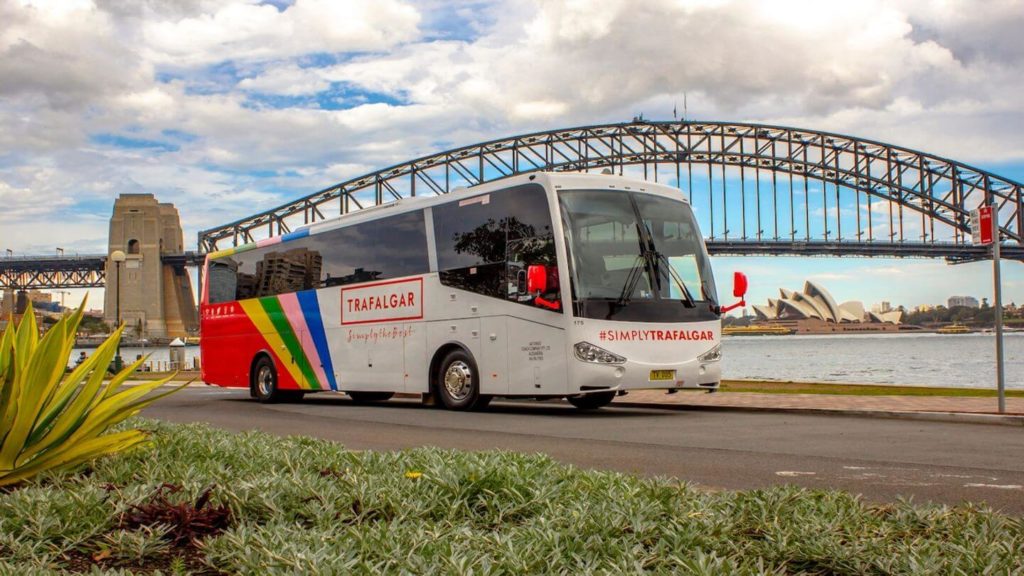Motion sickness can sneak up on anyone to spoil an otherwise brilliant vacation. The good news is that a few small choices about where you sit, what you look at, and when you take breaks can make a huge difference.
When it comes to tried-and-tested methods to ease the symptoms of motion sickness, few have as much experience as our North America Travel Director Todd Geist, who has spent hundreds of hours on the road. We spoke to him to get his top tips.

1) Pick the right seat before wheels roll
“One of my top tips is to be selective about where you sit – it can make a surprising amount of difference”, says Todd. “Sit in rows 3 or 4 as you’re over the front wheel and feeling the least motion. This is where we put people who tell us of chronic motion sickness. We can also take them out of seat rotation, so they can remain as comfortable as possible throughout their tour.”
Rows 3–4 are the sweet spot on a coach because you sit close to the front axle, which reduces the up-and-down and side-to-side movement you feel. If those rows aren’t available for any reason, aim for the front half of the coach on the aisle for a steadier ride and easier access during quick stops.
Tell your Travel Director at the welcome meeting if you are prone to motion sickness, and they will do whatever they can to make the driving legs more comfortable for you.

2) Get airflow right at your seat
“Another tip I’ve learnt is that if you’re sat in the window seat, you’ll feel more airflow coming from the overhead vent. Staying a comfortable temperature is a key component to reducing motion sickness.”
Feel like you need some cool, fresh air to settle your stomach? It’s scientifically proven that cooling yourself down – by exposure to fresh air, cold water or a compress – reduces your heart rate, stress levels and can ease nausea. So if you can, direct the overhead vent toward your face and neck.
Quick checklist
- Overhead vent open and angled slightly toward your cheek
- Window shade half open to reduce glare, not visibility
- Layers you can add or remove without fuss
3) Look out to the horizon and keep your head still
“If you’re feeling unwell it can be tempting to distract yourself by reading or watching something on a phone or tablet,” says Todd. “But this can make the symptoms worse. Instead, try and fix your gaze on the horizon – it has always worked for me.”
Your inner ear and your eyes need to agree about movement. Steady reference points like the horizon or the road ahead can help keep your sense of motion and balance in line. Keep your head against the headrest to reduce small movements. Save reading, emails, and reels for the hotel.
Coach habit to try: Count distant waypoints or scan for landmarks the TD mentions. It keeps your eyes far, steady, and engaged.

4) Eat and drink like an athlete, not like a critic
“It can be tough when you’re in destinations with fantastic food, but try and avoid heavy dishes and desserts that can leave you feeling sluggish and tired. Instead try and stick to light meals, avoid alcohol, and drink plenty of water.”
A heavy meal or a big glass of wine can tip a borderline stomach. Aim for light, salty snacks and steady water sips. Ginger tea, ginger candy, or ginger biscuits are your friends. If caffeine makes you jittery, cut back on strong coffee on travel days.
Snack ideas that travel well
- Plain crackers, breadsticks, or pretzels
- Banana or apple
- Ginger chews or ginger tea bag for the next cafe stop
- Electrolyte tablet for your water bottle
5) Plan for the twisty bits
“As a TD in North America we don’t get as many windy roads as parts of Europe, but even so I will always warn guests when we’re coming up to a steeper or more windy mountainous stretch so people can mentally and physically prepare.”
Use those heads-up moments. Freshen the air, adjust your seat, put the phone away, and take a few slow breaths. If you use wrist acupressure bands or pharmacist-recommended remedies, this is the time to put them on or take them as directed.
Good to know: Todd and your Driver also choose smoother routing where practical and pace the day with comfort stops. Tell the TD early if you need extra pauses.
6) Pack a tiny “steady kit”
No need for a pharmacy in your day bag. A simple kit covers 95% of cases.
Steady kit
- Ginger chews or tablets
- Reusable water bottle
- Light salty snack
- Wrist acupressure bands
- Wet wipes and mints
- Spare layer in case the coach is warm or cool
If you know you are sensitive, ask a pharmacist about non-drowsy options and how to use them. Always follow local guidance and your own clinician’s advice.

7) Use breaks like a reset button
On long drives your Travel Director will plan comfort stops. Step off the coach, get fresh air, walk a minute, and drink a few sips of water. Avoid scrolling during the break. Look far, stretch gently, and let your inner ear recalibrate.
Simple reset
- Two minutes of slow nasal breathing
- A short walk with eyes on distant points
- Light snack and water
8) What to do if you start to feel off anyway
Even perfect plans can wobble. If you feel warm or queasy:
- Open your vent and remove a layer.
- Fix your eyes on the road ahead or horizon.
- Breathe in for a count of four, out for a count of six, repeat for one minute.
- Try a ginger chew or mint.
- Tell your Travel Director. They can arrange a quick seat swap to rows 3–4 at the next safe moment.
9) Set yourself up the night before
Sleep well, charge devices, and lay out tomorrow’s layers and snacks. Avoid large late dinners and alcohol if the next day includes mountain passes or coastal roads. A calm start leads to a calm stomach.
Will I be the only one asking for a different seat?
No. TDs handle this quietly and often. Rows 3–4 are exactly for this.
Can I read on the coach if I don’t usually get sick?
If you are sensitive, skip reading and screens during winding sections. Save books for straight motorways or the hotel.
Do I need medicine?
Many guests do well with seat choice, airflow, and ginger. If you already know you struggle, ask a pharmacist or clinician about non-drowsy aids before you travel and follow their advice.